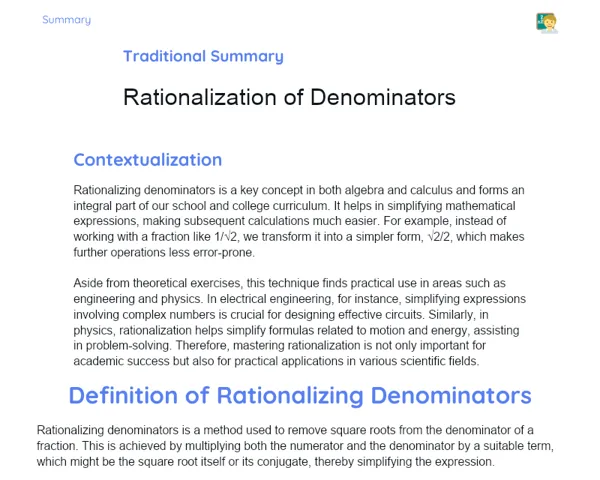Goals
1. Calculate the area of combined shapes made up of basic figures like triangles and rectangles.
2. Solve problems related to the total area of these shapes, such as figuring out the area of a house.
3. Develop the ability to break down complex shapes into simpler ones.
4. Enhance logical reasoning and the practical application of mathematical concepts.
Contextualization
Let's say you're assisting in designing a house layout. To determine how much flooring material is required, you need to calculate the total area of the rooms. These areas often aren't simple squares or rectangles but a mix of various geometric forms. Knowing how to calculate the area of combined shapes is crucial for tackling practical scenarios like this, which you might face in everyday life or future roles in fields like architecture and engineering. For instance, when arranging furniture in a room, understanding the available area is key to making the most of the space.
Subject Relevance
To Remember!
Breaking Down Combined Shapes
Breaking down combined shapes involves segmenting a complex figure into simpler geometric shapes like triangles and rectangles. This method makes calculating the total area easier, as it enables us to apply known formulas for basic shapes.
-
Divide complex shapes into smaller, more manageable parts.
-
Use area formulas for triangles and rectangles to calculate the areas of these parts.
-
Add up the areas of these parts to get the total area of the combined shape.
Calculating the Area of Triangles
To find the area of a triangle, we use the formula A = (base * height) / 2. This formula is applicable regardless of whether the triangle is equilateral, isosceles, or scalene.
-
Identify the base and height of the triangle.
-
Apply the formula A = (base * height) / 2.
-
Make sure that the base and height are in compatible units.
Calculating the Area of Rectangles
To calculate the area of a rectangle, we use the formula A = base * height. This is a straightforward formula since the base and height of a rectangle are always perpendicular to each other.
-
Identify the base and the height of the rectangle.
-
Apply the formula A = base * height.
-
Check that the base and height measurements are in the same unit.
Practical Applications
-
Architecture: In planning architectural projects, calculating the area of different rooms and spaces is crucial for optimizing space usage and preventing material waste.
-
Interior Design: While planning the layout of furniture and decor, it's important to calculate available area to ensure a functional and visually pleasing arrangement.
-
Civil Engineering: Accurately calculating the area of land and structures is imperative for constructing buildings, roads, and bridges, ensuring efficiency and precision in resource utilization.
Key Terms
-
Combined Area: The area of a figure that can be divided into simpler geometric figures, like triangles and rectangles.
-
Decomposition: The method of breaking down a complex figure into simpler geometric figures to facilitate area calculation.
-
Triangle: A geometric figure with three sides and three angles.
-
Rectangle: A geometric figure with four sides and four right angles (90 degrees).
Questions for Reflections
-
How can breaking down combined shapes assist in resolving complex mathematical problems?
-
In what ways can calculating the areas of combined shapes benefit your daily activities?
-
What other professions, apart from architecture and engineering, might find calculating the areas of combined shapes advantageous?
Designing and Calculating the Area of a Park
In this challenge, you'll design a park featuring various leisure areas such as rectangular courts, triangular gardens, and composite shapes for playgrounds. After creating the park layout, calculate the total area of each section as well as the overall park area.
Instructions
-
Sketch a park on graph paper, including at least three distinct areas: one rectangular court, one triangular garden, and a playground with a composite shape.
-
Break down the composite shape of the playground into simpler figures (triangles and rectangles).
-
Calculate the area of each simple figure using the appropriate formulas.
-
Add the areas of the simple figures to find the total area of the playground.
-
Calculate the total area of the park by summing the areas of the court, garden, and playground.
-
Double-check your calculations for accuracy.



